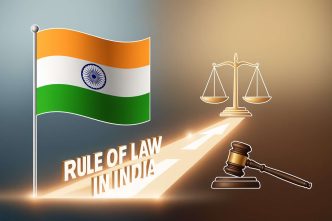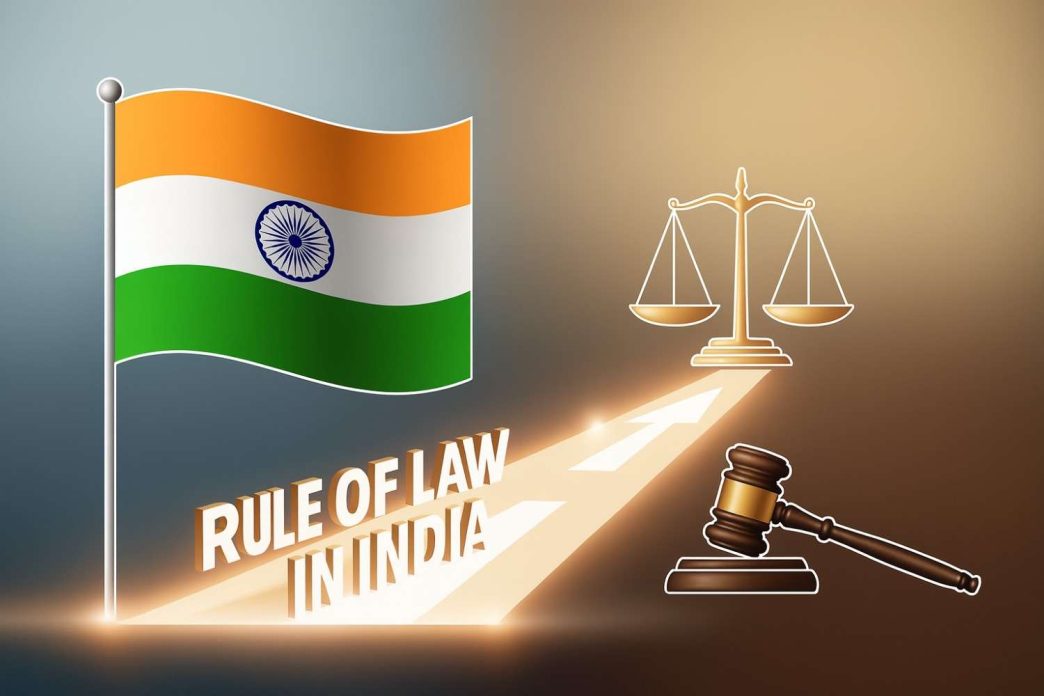A complete beginner’s guide to the Rule of Law in India. Learn its meaning, origin, principles, constitutional basis, importance, challenges, and real-world examples explained in simple terms.
Introduction
The Rule of Law is one of the most powerful ideas shaping modern democracies, including India. It represents the principle that law is supreme and no one is above it, ensuring citizens’ rights are protected, governments remain accountable, and justice is upheld.
For beginners, this may sound like a complex legal phrase, but in reality, it’s simple: the law — not individual authority — governs the nation. In India, this principle is deeply woven into the Constitution, the functioning of the legal system, and judicial decisions.
This article will explain the concept in simple terms, exploring its meaning, historical roots, constitutional basis, landmark cases, challenges, and role in everyday life.
1: Meaning of Rule of Law
The Rule of Law means that the law is the highest authority in the land, and everyone — from ordinary citizens to ministers, judges, and even the Prime Minister — must follow it.
Key aspects include:
- Supremacy of Law – Law is superior to personal or political power.
- Equality Before Law – All individuals, regardless of status, are equal.
- Protection of Rights – Citizens’ freedoms are safeguarded.
- Accountability of Government – State actions must be lawful and just.
In short, the ensures that no one can misuse power and everyone has equal access to justice.
2. Origin and Evolution

2.1 Ancient Roots
The idea of the Law is not new. Ancient India had legal codes like Manusmriti and Arthashastra, where rulers were expected to follow Dharma (moral and legal duties). Similarly, in ancient Greek and Roman philosophy, thinkers like Aristotle argued that the law must govern, not the whims of rulers.
2.2 A.V. Dicey’s Contribution
The modern meaning of Law comes from British jurist A.V. Dicey (1885). He explained three principles:
- Supremacy of Law – No arbitrary power; punishment only under law.
- Equality Before Law – Every citizen, regardless of rank, is subject to the ordinary courts.
- Predominance of Legal Spirit – Rights are enforced by courts, not granted by rulers.
2.3 Indian Context
India adopted the idea of the Law from the British system, but gave it a constitutional foundation through Articles 14, 19, 21, and judicial review powers of the courts.
3: Indian Constitution
Although the term Law is not directly written in the Constitution, it is embedded throughout its provisions.
3.1 Key Articles
- Article 14 – Guarantees equality before law and equal protection of laws.
- Article 19 – Ensures freedoms such as speech, movement, and profession.
- Article 21 – Protects life and personal liberty.
- Article 32 & 226 – Allow citizens to approach the Supreme Court or High Courts to enforce rights.
3.2 Separation of Powers
The Constitution divides power among the Legislature, Executive, and Judiciary, preventing any one branch from becoming too powerful.
3.3 Judicial Review
Indian courts can strike down unconstitutional laws or government actions. This ensures that every act of the government aligns with the Constitution.
4. Why Law and Equality Matter in India

4.1 Protects Fundamental Rights
The Rule of Law safeguards rights such as equality, freedom, and personal liberty from misuse by the state.
4.2 Prevents Misuse of Power
Without Rule of Law, leaders could misuse power arbitrarily. In India, the courts act as a check on such misuse.
4.3 Ensures Equality
Regardless of caste, class, religion, or political position, every citizen is bound by the same law.
4.4 Strengthens Democracy
Democracy survives only if the Rule of Law is upheld. It ensures free elections, accountability, and lawful governance.
4.5 Provides Justice
From small disputes to constitutional matters, Rule of Law ensures fair trials and remedies for violations.
5. Landmark Cases on Rule of Law in India
The Supreme Court of India has repeatedly emphasized the Rule of Law through judgments:
- Indira Gandhi vs. Raj Narain (1975): The court held that even the Prime Minister is not above the law.
- Kesavananda Bharati Case (1973): Introduced the Basic Structure Doctrine, making the Rule of Law a part of the Constitution’s unchangeable foundation.
- Maneka Gandhi vs. Union of India (1978): Expanded Article 21, strengthening personal liberty under the Rule of Law.
- ADM Jabalpur vs. Shivkant Shukla (1976): During Emergency, the court initially failed to protect rights, but later rulings reaffirmed the supremacy of the Rule of Law.
- I.R. Coelho vs. State of Tamil Nadu (2007): Declared that Rule of Law is part of the Constitution’s basic structure.
6. Everyday Examples of Rule of Law
For beginners, the Rule of Law may seem abstract, but it directly affects daily life:
- Police must act according to legal procedures before arresting anyone.
- Government cannot seize private property without legal authority.
- Citizens have the right to challenge unfair taxation in courts.
- Even high-ranking officials can be prosecuted for corruption.
These examples prove that the Rule of Law protects ordinary citizens from arbitrary power.
7. Challenges to Rule of Law in India
Despite its constitutional foundation, the Rule of Law in India faces several hurdles:
- Corruption: Weakens trust in justice systems.
- Judicial Delays: Over 4 crore pending cases in Indian courts hinder timely justice.
- Discrimination: Social and economic inequalities affect fairness.
- Police Excesses: Instances of custodial deaths and misuse of power weaken the principle.
- Arbitrary Government Actions: Emergency powers or misuse of laws often bypass legal safeguards.
- Lack of Awareness: Many citizens don’t know their rights under the Rule of Law.
8. Global Comparison of Legal Systems
India can learn from other democracies that uphold the Rule of Law strongly:
- United States: The Constitution explicitly guarantees checks and balances.
- United Kingdom: Rooted in common law and parliamentary sovereignty.
- European Union: Focus on human rights and international law.
- Scandinavian Nations: High transparency and strong enforcement of equality.
India follows a hybrid approach, adapting Dicey’s principles but strengthening them with constitutional safeguards.
9. Strengthening the Legal System in the Future

To make the Rule of Law stronger in India, reforms are needed:
- Judicial Reforms: Speed up case resolution with more judges and digital courts.
- Anti-Corruption Measures: Stronger laws and independent watchdogs.
- Police Reforms: Ensure accountability and citizen-friendly policing.
- Legal Awareness Campaigns: Educate citizens about their rights.
- Access to Justice: Provide affordable legal aid for marginalized groups.
10. Key Takeaways for Beginners
- The Rule of Law means everyone is equal before the law.
- It originates from A.V. Dicey’s principles but is enshrined in India’s Constitution.
- Article 14, 19, 21, and judicial review ensure its enforcement.
- Landmark cases have strengthened the concept in India.
- Despite challenges, the Rule of Law remains the foundation of Indian democracy.
FAQs
1. What does Rule of Law mean in India?
It means everyone, including government officials, is subject to the same laws.
2. Which Article ensures equality before law?
Article 14 of the Constitution guarantees equality before law and equal protection of laws.
3. Why is Rule of Law important in democracy?
It protects citizens’ rights, ensures accountability, and prevents misuse of power.
4. What challenges weaken the Rule of Law in India?
Corruption, judicial delays, and arbitrary actions by authorities.
5. Is Rule of Law part of the Constitution’s basic structure?
Yes, the Supreme Court has ruled that Rule of Law is part of the basic structure doctrine.
Conclusion
The Rule of Law in India is more than just a legal concept — it is the foundation of justice, equality, and democracy. For beginners, it can be summed up in one simple phrase: law is supreme, and no one is above it.
As India grows in the 21st century, the Rule of Law must be continuously protected and strengthened. A society where laws are respected, rights are upheld, and justice is accessible to all is the true sign of a successful democracy.
Know more related:
Medical Jobs in Government Sector








